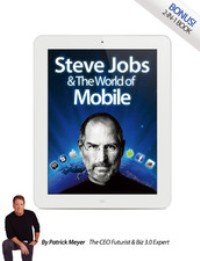In recent TV ads for Samsung Galaxy smartphones, two actors exchange a music playlist simply by tapping their phones together. This quick and easy method for exchanging information is enabled by Near Field Communication (NFC) technology. It isn’t a particularly prevalent feature on smartphones yet. But given NFC’s functionality—it is particularly useful for applications like secure contactless payment—it seems likely to be a ubiquitous feature on smartphones in the future.
So last week, when I had the opportunity to attend a launch event for what was billed as the first-ever NFC-enabled print book, I was intrigued. (Ed. Note 2/1/2013: Craig Tadlock, founder of NFC hardware and software developer GoToTags wrote to inform me that during November 2011, Simon & Schuster imprint Atria shipped the first 1,000 copies of Gary Schwartz’ The Impulse Economy: Understanding Mobile Shoppers and What Makes Them Buy with NFC-enabled stickers on their front covers.)
 “This technology is capable of transforming media,” Patrick Meyer, futurist and author of Steve Jobs and the World of Mobile, and Apps the Inside Scoop (a 2 in 1 book) told the group gathered for the launch. As a marketing consultant, Meyer has worked with major Fortune 500 companies including Coca-Cola, Ford, and Proctor & Gamble, and many of the uses he described for NFC were marketing oriented. Kraft, for example, recently ran a pilot test using “shelf talkers” in front of Nilla Wafers displays at a handful of U.S. supermarkets. Tap your NFC enabled phone on the shelf talker, and an interactive cookie, and then a dessert recipe, would appear on your smartphone screen. According to Meyer, Kraft was impressed with the results. The thousands of people who used the shelf talker spent almost 50 seconds interacting with the ad and the recipe.
“This technology is capable of transforming media,” Patrick Meyer, futurist and author of Steve Jobs and the World of Mobile, and Apps the Inside Scoop (a 2 in 1 book) told the group gathered for the launch. As a marketing consultant, Meyer has worked with major Fortune 500 companies including Coca-Cola, Ford, and Proctor & Gamble, and many of the uses he described for NFC were marketing oriented. Kraft, for example, recently ran a pilot test using “shelf talkers” in front of Nilla Wafers displays at a handful of U.S. supermarkets. Tap your NFC enabled phone on the shelf talker, and an interactive cookie, and then a dessert recipe, would appear on your smartphone screen. According to Meyer, Kraft was impressed with the results. The thousands of people who used the shelf talker spent almost 50 seconds interacting with the ad and the recipe.
Similarly, an NFC chip on the cover of Meyer’s book allows users to access a video interview with Meyer simply by tapping the book with their phone. Although the technology itself is a closer cousin to RFID, in terms of these types of applications, NFC could be described as a much faster, much simpler version of the QR code.
The book itself offers a snapshot of current trends in mobile apps, mobile technology, and social media, using Steve Jobs and the rise of the iPhone and iPad as an anchor. Topics ranging from product design to marketing to trend forecasting to competition between major tech corporations are broken down into single page summaries with lots of graphs, photos, and logos. It could make a good easy reading gift for someone interested in tech trends, and the apps portion of the book holds several interesting surprises. However, the organization of the title won’t make the book useful as a reference text, and in such a fast-moving field, much of the information inside could quickly become dated.
Yet Meyer’s use of NFC in a print book raises interesting possibilities. As he mentioned during his presentation, these chips could quickly take users to updates on the text, or allow them to access multimedia much more quickly than QR codes or even augmented reality apps. Or, as Meyer has already done, they can be used to help market a title, giving users a quick hit of information that will motivate them to open up the cover and read more.
![]()
![]()
![]()
![]()
![]()
![]()
![]()
![]()

